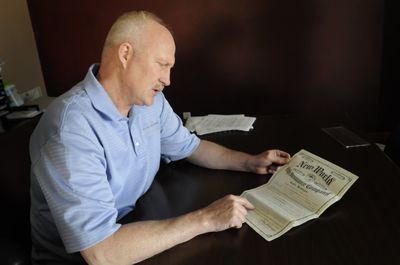Falling premiums heighten interest in life insurance

David Boley is a Farmers Insurance agent who’s seeing life insurance from both sides lately.
On the one hand, despite the poor economy, there’s a steady interest in life insurance these days, what with falling premiums and an erosion in people’s sense of security.
On the other, he recently paid the death benefit of a life insurance policy to heirs of a man who bought it in 1940 at age 22. Boley got the antique policy document back – a reminder to him of the community connections and longtime commitment that his business entails.
The man who bought that policy all those years ago – and who died recently at age 90 – was Alick Simchuk, a longtime farmer and owner of a sporting goods store. He followed the best advice there is when it comes to life insurance: Buy it when you’re young and healthy.
Of course, a lot of people don’t really need life insurance when they’re 22. And even if it’s cheaper for that healthy 22-year-old, it’s still possible to get insured if you’re in your 30s, 40s, 50s or older – though you pay a price depending on a wide range of circumstances, including your health.
Here are a few things to consider about life insurance:
1
Prices have been dropping. As people live longer, the price of life insurance has been steadily decreasing. Average prices fell by 15 percent a year during the 1990s, and by around 4 percent a year since 2000, according to the Insurance Information Institute. Last year, a $500,000, 20-year level term policy for a 40-year-old man averaged about $725 a year for a “standard” risk, and less than half that for a “preferred” risk, according to the institute.
2
That means more people are interested. During a recession, people may look to cut their expenses – but they also get a heightened sense of vulnerability. “I have seen an increased interest in life insurance,” said Donna Maguire, who owns an Allstate Insurance agency in Spokane. “I think part of it might be due to the economy. People are realizing their jobs are vulnerable.” Nationally, sales of life insurance grew by around 5 percent a year between 2003 and 2007, more than other forms of insurance such as home and auto, according to Datamonitor, an industry research firm. That flattened during 2008, but sales of term life insurance – the simplest, cheapest option – remained strong.
3
Not all kinds of life insurance are booming. There are two main kinds of insurance. Term life is relatively inexpensive and covers you for a period of time, from 10 to 30 years. If you die during the term, your heirs receive the full value; once the term expires, they receive nothing. Financial advisers tend to see this as the best option for a family looking to cover immediate expenses in the event of a death.
Whole life policies are more expensive and operate as both insurance and investment for estate planning. They stay in place until you stop paying the premiums or die. Sales of whole life, and variations on it, plummeted late last year, as concern over the stock market grew.
Some financial advisers have told people for years to stick to term life and avoid insurance as an investment – the common advice has been “buy term and invest the rest.”
4
The traditional model is changing. Remember that 22-year-old? These days, agents say, it’s more common for those buying life insurance to be in their 30s, sometimes 40s. And it’s less common for a family to buy a policy to simply replace the husband’s earnings. Often, both parents work, and sometimes the man’s income isn’t the largest. “Historically, men have always gotten the insurance in the family,” Maguire said. “That’s not the case so much anymore.”
5
The first step is to figure out your goals. On a fundamental level, most people use life insurance to ensure their families are taken care of if they die – calculating how much it would take to replace their income until retirement, factoring for inflation. But rules of thumb aren’t very useful for specific families. Different people have different goals – some want to replace income, some want to simply cover the mortgage, others want to leave money for heirs to take care of taxes, college or other expenses. If you’re planning to buy life insurance, you’ll need advice from a financial adviser or agent who can help you take your whole financial picture into account.
6
Then, consider your health. Insurers will want to give you an exam and question you about your health habits. Smoking, obesity, disease – all can make life insurance harder to get and more expensive. And your premiums will also rise as you age. “I always say the best time to buy life insurance is today, because tomorrow you’re going to be a day older,” Boley said. Insurers may also want to know about your family’s history of heart disease or cancer. How is your driving record? Do you have risky hobbies or travel to countries that are enmeshed in civil wars?
7
Think about the long term. Boley found himself reminded of this recently, when he saw the 1940 policy. The money went to three adult children of the deceased, Simchuk. But Boley, a 15-year insurance agent who spent a good part of his youth in Eastern Washington, said that the circumstances were fraught with community connections and coincidence. Simchuk owned the sporting goods store where Boley and his peers shopped as young athletes. His sister grew up with members of the family. He learned to ski in a program through the store. And the daughter of Simchuk’s who filed the claim was a middle school teacher of Boley’s. “It was rewarding to me that she gave me the policy,” he said. “Now it’s an antique.”